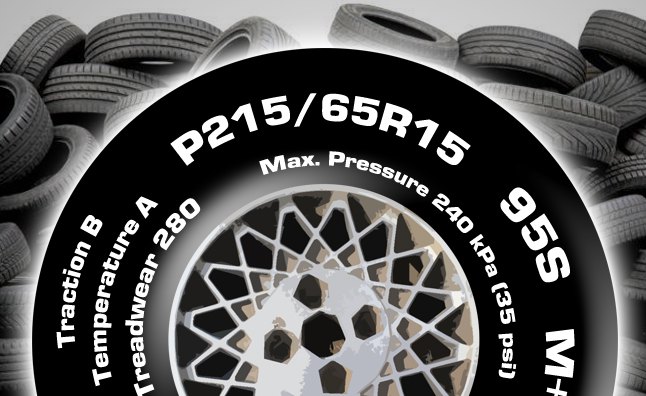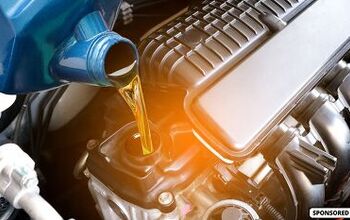Under the Hood - What Does the Writing On My Tires Mean?

The average motorist doesn’t give them a second thought, but tires are mission-critical components. They’re as important to cars and trucks as spacesuits are to astronauts. Without them you literally couldn’t drive anywhere.
Tires directly impact how a vehicle rides, steers and stops. Even the best-driving car in the world could handle like a cement truck if it’s running on the wrong rubber.
As vital as tires are they’re one of the most overlooked parts of a vehicle. Many people know to change their car’s oil, or service the brakes, but tires seem like a complete afterthought.
Why do they get ignored? Part of the reason is probably because they’re confusing. Take a peek at the sidewall of one of these things – it looks like an algebra equation there are so many numbers and symbols. What does all of this gibberish mean? A simple explanation will go a long way to clearing up this automotive enigma.
A lot of times the first thing you’ll notice on the sidewall is a big honkin’ letter that precedes a bunch of numbers. Usually it’s presented in a large font so it’s easy to read. The letter “P” stands for “passenger” while “LT” it means “light truck.” Of course there may not be any letter at all. If that’s the case Berger said the tire is likely Euro-Metric, meaning all the testing has been done to European standards.
Following any letters the next most obvious thing on the sidewall should be a few numbers. Berger said “they tell you the width of the tire in millimeters.” So, for instance if 215 follows the letter “P” you know you’re looking at a passenger-car tire that is 215 millimeters across, which is about eight and a half inches.
Next comes a slash, which separates the width figure from another number. According to Berger this is the aspect ratio of the tire, which is the relationship between the sidewall height and the width. He said “a lower aspect ratio is typically a high-performance tire.” This means they have shorter sidewalls, which tend to flex less during cornering, resulting in better handling.
SEE ALSO: Why You Should, or Shouldn’t Buy Run-Flat Tires
After the aspect ratio comes another letter. In the U.S. it’s almost universally an “R,” which stands for “radial.” This describes how the different layers of the tire were arranged during manufacturing. Berger said, “believe it or not in other parts of the world the old bias-ply tire is still sold.” In many ways these are inferior to modern radials. They do not have the letter “R” on their sidewalls. After the radial designation comes another number; this corresponds to the rim diameter in inches.
“After the size description there is going to be a series of numbers and letters,” Berger said. “The first part of that is a number, typically between 70 and 130.” He said, “The number itself is an index. The Tire and Rim Association has the information to exactly what load that tire can carry at various inflation pressures.” Basically this is how much weight a tire can safely support. The higher the number, the more it can carry.
Berger said you never want to put a tire on your vehicle with a load index that is lower than what the manufacturer specifies. However, it’s not a problem to exceed that number.
SEE ALSO: Why Your Next Set of Tires May be Made from Weeds
Immediately adjacent to the load index is the speed rating, which indicates the maximum velocity a tire can safely handle. This too is expressed with a letter. “There are probably 10 or so speed ratings out there” Berger said, covering “a pretty significant range of speeds.”
According to him, “S” is the lowest rating, with one exception. These tires top out at just 112 miles an hour. However, “Q” is reserved exclusively for snow tires. Q-rated rubber can only handle 99 mph.
“Y” is at the opposite end of the spectrum. These tires can safely manage speeds of 186 miles per hour. As you’d expect they tend to be found on performance cars. Interestingly, in special cases the “Y” will have parentheses around it. According to Berger this indicates and even higher top speed. Yes, higher than 186 mph!
As with the load rating, it is strongly recommended drivers replace their tires with new ones that meet or exceed the speed rating suggested by the manufacturer. All of this information can be found in one place, a placard that’s usually located on the driver’s side door jamb. Sometimes it’s located inside the fuel filler door or in the owner’s manual, but “the vast majority of the time you’re going to find it on the door jamb,” Berger said.
SEE ALSO: Why You Need Snow Tires
Why are tires speed rated? “Heat is one of the factors,” said Berger. They get surprisingly hot rolling down the highway at 75 miles an hour… or more. He also said, “at higher speeds centrifugal force increases exponentially,” putting a lot of strain on them.
According to Berger, “the speed rating also has a direct impact on the handling characteristics of the tire. A higher speed-rated tire will invariably have much higher handling and grip capability. [At Bridgestone] we prefer to call that ‘performance rating.’”
Next up is the tread-wear score. This is expressed as a number in the hundreds – 280, or 400 for instance. The higher the number the more resistant a tire is to wear. Berger said “While actual treadlife is determined by a range of factors, a higher number is generally better for comparison purposes”.
After tread wear comes the traction rating, though Berger noted the test that determines this score is actually wet traction. The scale switches from numbers back to letters for this metric. Tires are rated “AA,” “A,” “B” or “C.” As you might expect, “AA” is the best.
Sticking with letters, the temperature score comes next. Tires are rated “A,” “B” or “C.” Again “A” is the best, meaning a tire can handle the highest temperatures.
Last but not least, if a tire has “M+S” on the sidewall it’s designed for severe conditions. Actually, it stands for “mud and snow,” but it corresponds to an all-season tire. Summer tires will not have this on their sidewalls.
“The all-season tire is popular in north America for the typical customer that does not live in a severe-climate area,” Berger said. Switching between summer and winter rubber is much more common in Europe.
Of course there’s a lot more listed on tire sidewalls, things like the company name, DOT serial numbers and tire model to name a few. Additionally, an inflation number will be listed. Berger said “that pressure is simply the maximum pressure the tire is designed to carry.” But do not put that much air in the tire he warns. “Always follow the door jamb.”
Manufacturers arrive at their pressure ratings after exhaustive testing that can take years to complete. It’s best to follow their vehicle-specific recommendations. Also, Berger advises checking your vehicle’s tire pressure at least once every month. He said they generally lose around one pound of pressure every 30 days, sound advice for all drivers.
GALLERY: What Does the Writing On My Tires Mean?

Born and raised in metro Detroit, Craig was steeped in mechanics from childhood. He feels as much at home with a wrench or welding gun in his hand as he does behind the wheel or in front of a camera. Putting his Bachelor's Degree in Journalism to good use, he's always pumping out videos, reviews, and features for AutoGuide.com. When the workday is over, he can be found out driving his fully restored 1936 Ford V8 sedan. Craig has covered the automotive industry full time for more than 10 years and is a member of the Automotive Press Association (APA) and Midwest Automotive Media Association (MAMA).
More by Craig Cole











































Comments
Join the conversation